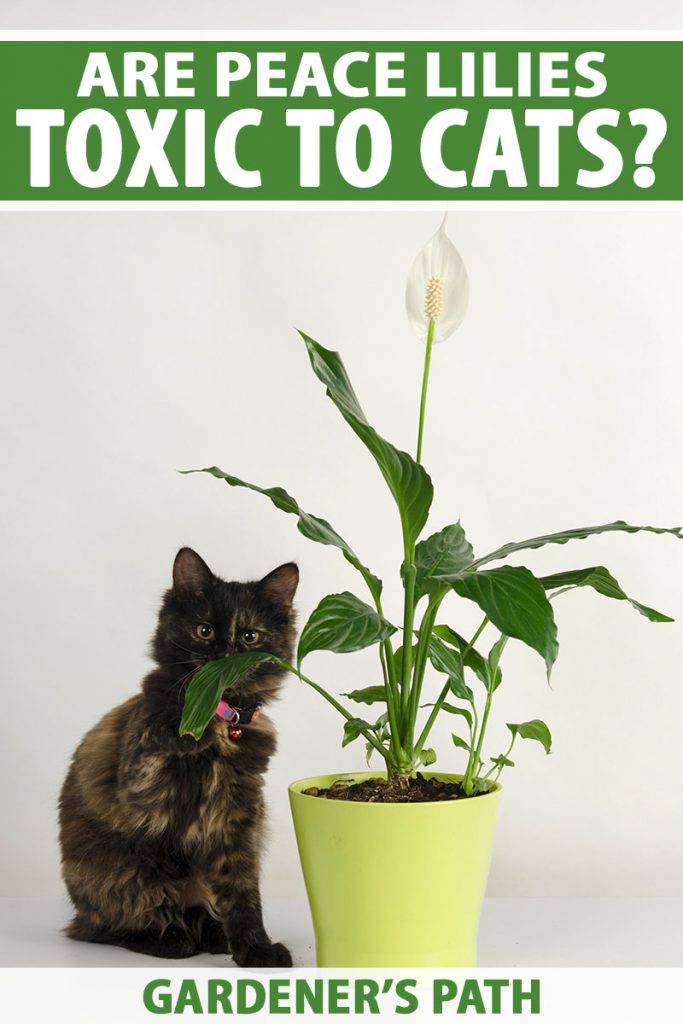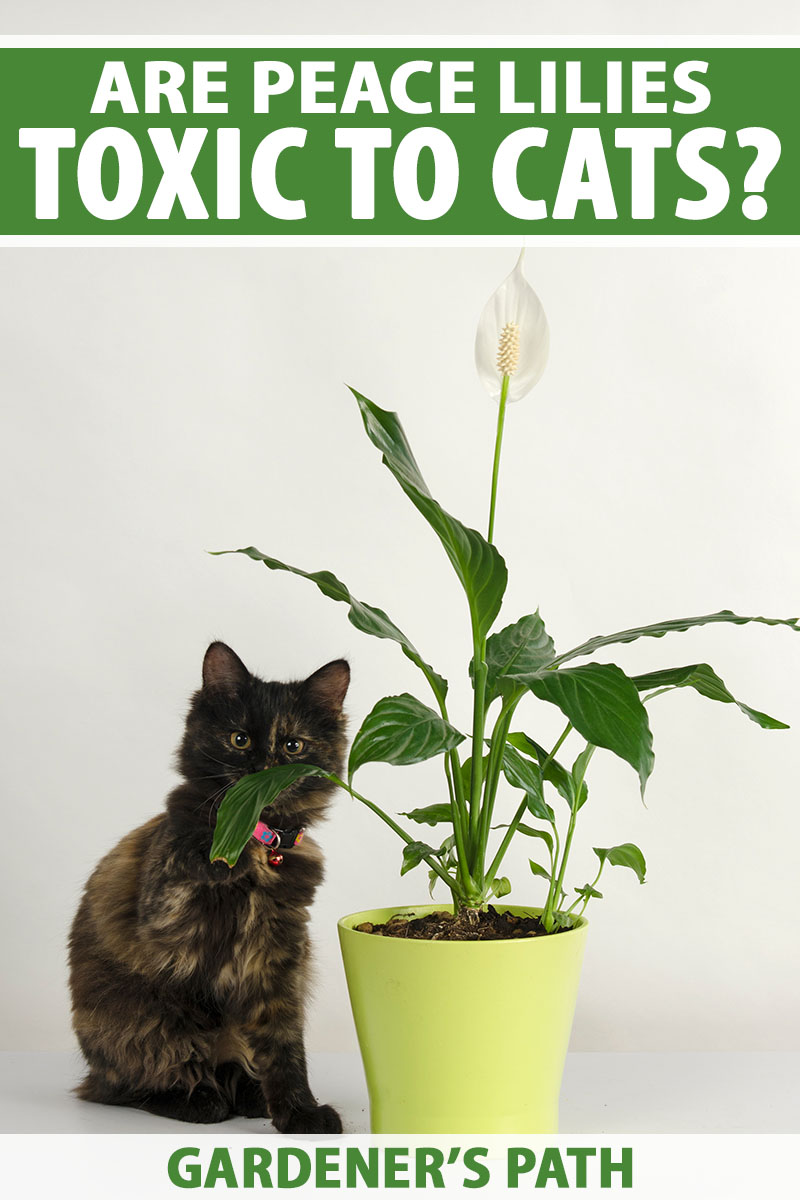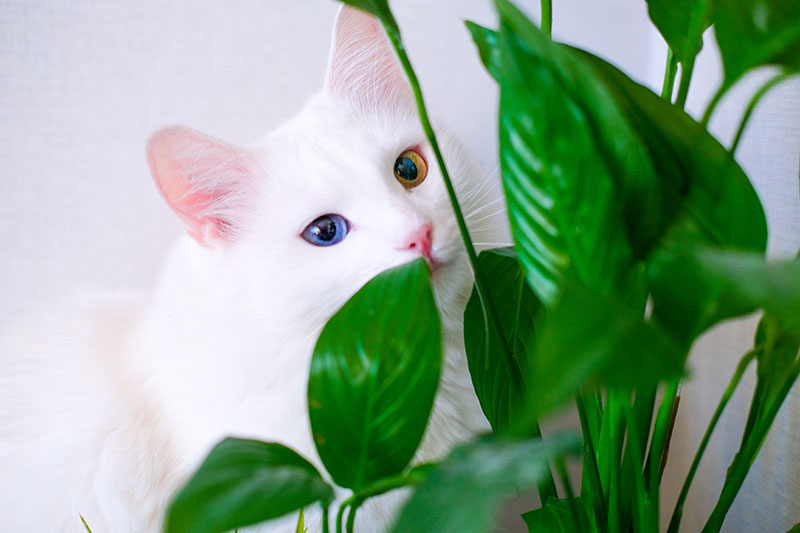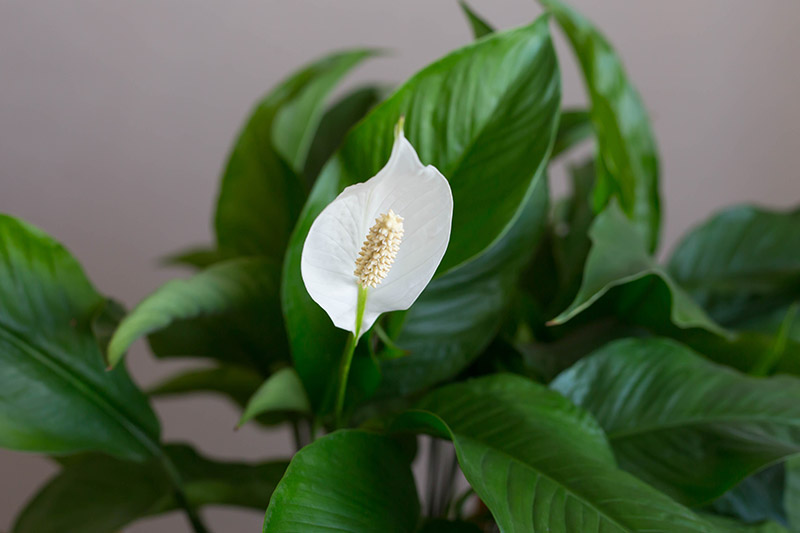Of course, you immediately rush into action and try to discover what’s wrong. You notice that chunks are missing out of your peace lily plant (Spathiphyllum spp.). Uhoh. Is this truly a crisis? We link to vendors to help you find relevant products. If you buy from one of our links, we may earn a commission. Even so, call your vet immediately! Your kitty is very uncomfortable, but she should survive the ordeal. If she had eaten a true lily (belonging to the Lilium genus), or even drank water from a vase containing cut lilies of this type, her fate could be very different, involving acute kidney failure. Fortunately, the level of toxicity related to this houseplant is typically much more mild. Read on to learn all the symptoms of peace lily poisoning, and what to do if your cat ingests part of this plant. Here’s what we’ll cover: What’s up with peace lilies? Do they come in the name of peace, only to poison your pets? Don’t hold this against them. More than 215 families of plants have members that produce the same poison involved here – calcium oxalate (CaOx) crystals. Among other functions, these serve to help plants to regulate calcium levels, and prevent herbivory – or in other words, these poisons can help to protect them from being eaten.
Symptoms of Poisoning
According to the Pet Poison Helpline, the common signs of poisoning in cats from consuming parts of commonly grown species of peace lily plants include:
Drooling Oral pain Pawing at the mouth Vomiting Decreased appetite
These occur immediately after the animal chews on the foliage. One of the major reasons for these symptoms in your pet is that the crystals of calcium oxalate are like microscopic spears. They penetrate the tissue in your cat’s mouth, including the gums and tongue, and down to the throat and esophagus, and cause intense burning. Who could blame your kitty for yowling under the circumstances? Your cat’s meow may even have a different tone, due to the intense pain and drooling. It is possible for the upper airway to swell, which makes it difficult to breathe. Fortunately this symptom is rare when peace lilies are the culprit.
How to Treat Cats Poisoned by Peace Lilies
The good news is that the pain and discomfort will go away on their own – usually within a few hours.
You can also help to soothe the irritation by giving your pet some chilled lactose-free milk or yogurt. Too much lactose can cause diarrhea, and most adult animals are lactose intolerant, so regular dairy products should be avoided if possible, or administered sparingly. There are many different species of plants that may be toxic to cats, and identification can be key to proper treatment. If you bring your pet to the vet, take a cutting of the peace lily, or take a photo on your phone to help the vet with their diagnosis.
Other Plants in the Same Family Also Pose a Threat
You might be able to guess from the pretty flowers and bracts produced by peace lilies that these plants are in the arum family, Araceae. Many other common houseplants in this family also produce insoluble calcium oxalate crystals. These include dumb cane (Dieffenbachia), calla lily, pothos, philodendron, umbrella tree (Schefflera), elephant’s ear, and Chinese evergreen. When in doubt, always keep pets and young children away from your houseplants, and call poison control or your doctor or veterinarian if accidental ingestion may be a concern.
Where Is Calcium Oxalate Found?
You may be wondering, do plants that produce CaOx crystals create these in higher concentrations in the leaves, flowers, roots, or other parts? Well, the fact is, in plants that produce it, you can find calcium oxalate pretty much everywhere. But overall, only some actually produce large quantities of this toxin.
According to a paper on this topic published by Sevil Tütüncü Konyar et al in the journal Botanical Studies in 2014, crystals of calcium oxalate have been found in the roots, leaves, stems, seeds, and flowers of certain plants. In fact, you have probably enjoyed eating edible plants that contain some level of oxalic acid (the soluble form of oxalate) without even realizing it. Have you ever nibbled on a member of the wood sorrel genus, plants that look kind of like clover, with a nice tangy taste? Oxalis is the namesake of this genus, and that’s no coincidence! Wood sorrel has been known to contain oxalic acid since the 17th century. In fact, the Dutch botanist and physician Herman Boerhaave first isolated an oxalic acid salt from this type of plant in 1745. Oxalates are also found in beets, spinach, swiss chard, and kale, as well as beet and turnip greens, rhubarb, sweet potatoes, peanuts, and other edible plants. Most healthy people can consume the low concentrations of oxalates found in these plants on a regular basis without any problems, but some individuals with kidney or digestive problems may need to make changes to their diets, as advised by a healthcare professional. Oxalic acid even has industrial uses. It is used as an acid rinse in laundries, because it is so effective at removing rust and ink stains, and it is also used to remove scale from vehicle radiators. Yikes! That sounds like a really nasty chemical! Plants, on the other hand, contain much lower concentrations of oxalic acid than what would be required for caustic industrial use. As mentioned above, the irritating CaOx crystals help plants to prevent themselves from being eaten by foraging animals – a definite benefit, since they cannot just run away like other living organisms! Interestingly enough, these crystals may form in the human body as well. Calcium oxalate is one of the major constituents of kidney stones. If you have ever experienced the excruciating pain associated with passing one of these, you can probably blame this crystalline chemical compound for that as well.
If your cat is prone to biting, chewing on, or consuming attractive flowers or leaves, you may want to reconsider keeping this and other potentially poisonous houseplants in your home. And please remember, if your cat eats part of any plant that is not regularly consumed as part of its regular diet, poisonous or not, this may result in an upset stomach due to mechanical irritation. Has one of your pets taken to nibbling on your houseplants? Please take the proper precautions to provide the best care and a safe environment for your animals, and let us know what some of your favorite cat-friendly plants are in the comments! Read on for more information about growing peace lilies at home:
How to Grow and Care for Peace Lily 5 Reasons Why Peace Lilies May Not Bloom Tips to Identify and Prevent Peace Lily Diseases
© Ask the Experts, LLC. ALL RIGHTS RESERVED. See our TOS for more details. Uncredited photos: Shutterstock. With additional writing and editing by Allison Sidhu.




